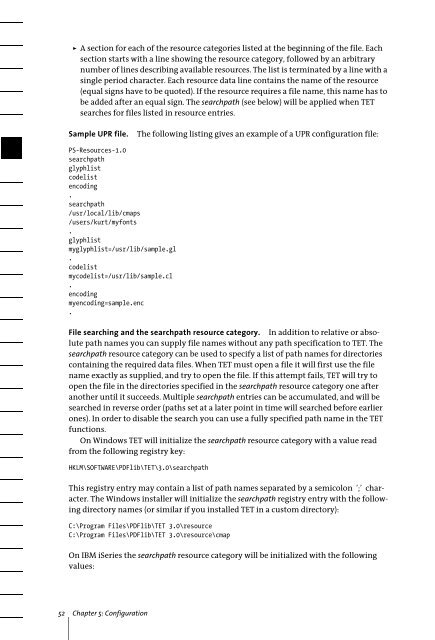PDFlib Text Extraction Toolkit (TET) Manual
PDFlib Text Extraction Toolkit (TET) Manual
PDFlib Text Extraction Toolkit (TET) Manual
You also want an ePaper? Increase the reach of your titles
YUMPU automatically turns print PDFs into web optimized ePapers that Google loves.
A section for each of the resource categories listed at the beginning of the file. Each<br />
section starts with a line showing the resource category, followed by an arbitrary<br />
number of lines describing available resources. The list is terminated by a line with a<br />
single period character. Each resource data line contains the name of the resource<br />
(equal signs have to be quoted). If the resource requires a file name, this name has to<br />
be added after an equal sign. The searchpath (see below) will be applied when <strong>TET</strong><br />
searches for files listed in resource entries.<br />
Sample UPR file.<br />
The following listing gives an example of a UPR configuration file:<br />
PS-Resources-1.0<br />
searchpath<br />
glyphlist<br />
codelist<br />
encoding<br />
.<br />
searchpath<br />
/usr/local/lib/cmaps<br />
/users/kurt/myfonts<br />
.<br />
glyphlist<br />
myglyphlist=/usr/lib/sample.gl<br />
.<br />
codelist<br />
mycodelist=/usr/lib/sample.cl<br />
.<br />
encoding<br />
myencoding=sample.enc<br />
.<br />
File searching and the searchpath resource category. In addition to relative or absolute<br />
path names you can supply file names without any path specification to <strong>TET</strong>. The<br />
searchpath resource category can be used to specify a list of path names for directories<br />
containing the required data files. When <strong>TET</strong> must open a file it will first use the file<br />
name exactly as supplied, and try to open the file. If this attempt fails, <strong>TET</strong> will try to<br />
open the file in the directories specified in the searchpath resource category one after<br />
another until it succeeds. Multiple searchpath entries can be accumulated, and will be<br />
searched in reverse order (paths set at a later point in time will searched before earlier<br />
ones). In order to disable the search you can use a fully specified path name in the <strong>TET</strong><br />
functions.<br />
On Windows <strong>TET</strong> will initialize the searchpath resource category with a value read<br />
from the following registry key:<br />
HKLM\SOFTWARE\<strong>PDFlib</strong>\<strong>TET</strong>\3.0\searchpath<br />
This registry entry may contain a list of path names separated by a semicolon ’;’ character.<br />
The Windows installer will initialize the searchpath registry entry with the following<br />
directory names (or similar if you installed <strong>TET</strong> in a custom directory):<br />
C:\Program Files\<strong>PDFlib</strong>\<strong>TET</strong> 3.0\resource<br />
C:\Program Files\<strong>PDFlib</strong>\<strong>TET</strong> 3.0\resource\cmap<br />
On IBM iSeries the searchpath resource category will be initialized with the following<br />
values:<br />
52 Chapter 5: Configuration
















